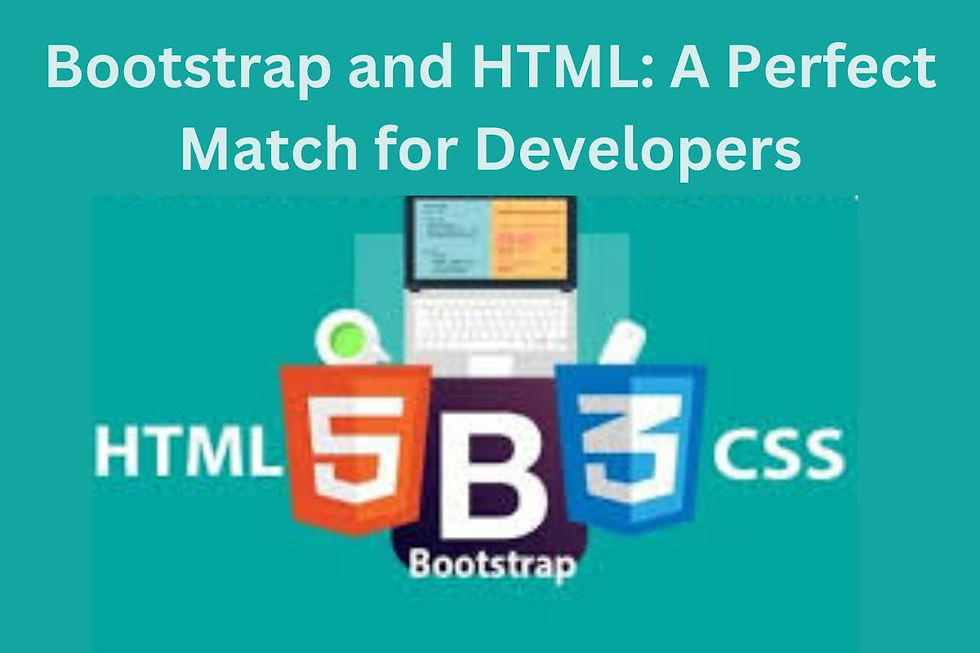Bootstrap and HTML: A Perfect Match for Developers
- archi jain

- Oct 7, 2024
- 4 min read

Bootstrap and HTML are essential tools in modern web development. While HTML provides the foundational structure of web pages, Bootstrap enhances it with pre-designed components and responsive design capabilities. This powerful combination enables developers to create visually appealing, user-friendly websites efficiently, making them a perfect match for anyone looking to build engaging web experiences.
What is HTML?
HTML is the backbone of any website. It provides the structure and framework for web content. Think of it as the skeleton of a webpage, allowing you to organize text, images, links, and other elements.
Key Features of HTML:
Structure: HTML uses tags to define elements like headings, paragraphs, and images. Each tag serves a specific purpose, helping to organize the content logically.
Semantics: Modern HTML (HTML5) introduces semantic elements, such as <header>, <footer>, and <article>, which give meaning to the content. This is important for accessibility and search engine optimization (SEO).
Multimedia Support: HTML allows for the integration of multimedia elements, making it possible to embed videos, audio, and images easily.
What is Bootstrap?
Bootstrap is a popular front-end framework that makes web development faster and easier. Developed by Twitter, it offers a collection of pre-designed components and templates that help developers create responsive and visually appealing websites.
Key Features of Bootstrap:
Responsive Grid System: Bootstrap’s grid system allows developers to create layouts that adapt to different screen sizes. This means your website will look great on desktops, tablets, and smartphones.
Pre-styled Components: Bootstrap comes with a variety of pre-styled elements, such as buttons, forms, navigation bars, and alerts. This saves developers time and effort, allowing them to focus on functionality rather than design.
Customizable: While Bootstrap provides default styles, it’s also highly customizable. Developers can easily modify colors, fonts, and layouts to match their branding or project requirements.
JavaScript Plugins: Bootstrap includes built-in JavaScript plugins that enhance functionality. These can add features like carousels, modals, and dropdown menus without requiring extensive coding.
How Bootstrap Enhances HTML
While HTML lays the foundation of a webpage, Bootstrap adds the finishing touches that make it visually appealing and responsive. Here’s how they complement each other:
1. Easy Integration
Integrating Bootstrap into an HTML project is straightforward. Developers can either link to a hosted version (CDN) or download the files for local use. This ease of integration means you can quickly start building your website with minimal setup.
2. Streamlined Layout Creation
Bootstrap’s grid system allows developers to create complex layouts easily. Instead of writing custom CSS for each element, you can use Bootstrap’s predefined classes to define how content is arranged. This enables a consistent and responsive design across different devices.
3. Enhanced Styling
Bootstrap provides a range of styling options that can be applied directly to HTML elements. For instance, you can transform a simple button into a visually appealing component with just a few class additions. This means less time spent on CSS and more focus on building functionality.
4. Responsive Design Made Easy
One of the standout features of Bootstrap is its focus on responsive design. By using Bootstrap’s responsive utilities, developers can ensure that their website looks great on any screen size. This adaptability is crucial in today’s mobile-first world, where users access websites from various devices.
5. Built-in Accessibility
Bootstrap promotes best practices for accessibility, ensuring that your website is usable by people with disabilities. By using semantic HTML and Bootstrap’s components, developers can create sites that are more inclusive.
Why Use Bootstrap with HTML?
1. Speed Up Development
By combining Bootstrap with HTML, developers can speed up the web development process. Pre-designed components reduce the need to start from scratch, allowing you to launch projects faster.
2. Consistent Design
Bootstrap’s uniformity in design ensures that all elements match, providing a cohesive look throughout the site. This is especially useful for teams, where maintaining consistent styles can be challenging.
3. Strong Community and Resources
Bootstrap has a large community of developers who contribute to its evolution. This means there are plenty of resources, tutorials, and forums available to help you troubleshoot or learn more about best practices.
4. Ongoing Support and Updates
As a widely used framework, Bootstrap receives regular updates, ensuring it stays relevant with the latest web standards and practices. This ongoing support means you can build your projects on a solid foundation.
Conclusion
HTML and Bootstrap form a powerful combination for web developers. HTML provides the essential structure, while Bootstrap enhances it with styling and responsiveness. By mastering these tools, particularly in a Full Stack Developer Course in Noida, Delhi, Gurgaon, and other locations in India, you can create beautiful, user-friendly websites more efficiently. Whether you’re a beginner or an experienced developer, using Bootstrap with HTML can streamline your workflow and elevate your web projects. Happy coding!
FAQs
1. How does Bootstrap enhance HTML?
Bootstrap adds styling, layout options, and responsiveness to HTML, allowing developers to create attractive, mobile-friendly websites more easily.
2. Is Bootstrap easy to learn?
Yes, Bootstrap is designed to be user-friendly, making it accessible for both beginners and experienced developers.
3. Can I customize Bootstrap components?
Absolutely! Bootstrap components are highly customizable, allowing you to tailor them to fit your project's specific needs.
4. What are some benefits of using Bootstrap?
Using Bootstrap speeds up development time, ensures consistency in design, and provides built-in responsive features, making it ideal for web projects.
5. Is Bootstrap suitable for all types of websites?
Yes, Bootstrap can be used for various types of websites, from simple landing pages to complex web applications.








Comments